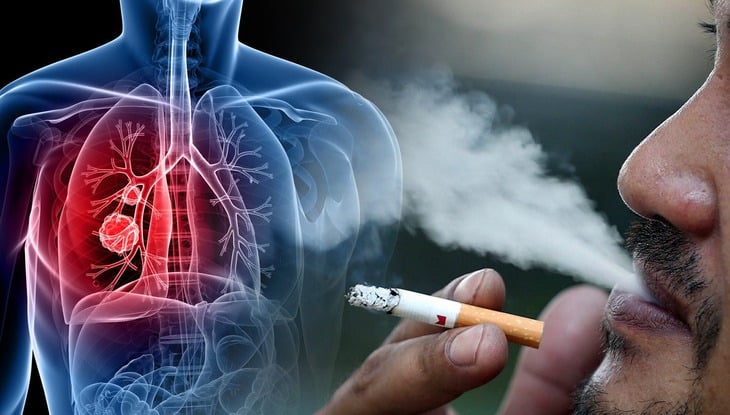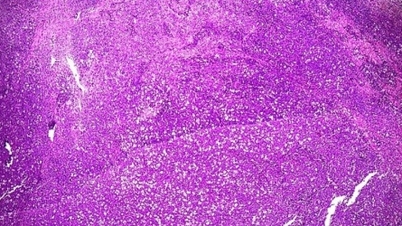According to the World Health Organization (WHO), there will be 20 million new cancer cases and 9.7 million deaths in 2022. The most common cancers are lung, breast, and colorectal cancer.
Medical news on November 9: Burden of cancer in Vietnam; dengue fever cases in Ho Chi Minh City still increasing
According to the World Health Organization (WHO), there will be 20 million new cancer cases and 9.7 million deaths in 2022. The most common cancers are lung, breast, and colorectal cancer.
Three common cancers in Vietnam
According to GLOBOCAN 2022 statistics, Vietnam recorded 180,480 new cases and 120,184 deaths from cancer. The mortality rate is high, especially for common cancers such as liver, lung, and stomach cancer in men and breast, lung, and liver cancer in women.
 |
| According to the World Health Organization (WHO), there will be 20 million new cancer cases and 9.7 million deaths in 2022. The most common cancers are lung, breast, and colorectal cancer. |
In particular, a significant proportion of patients are only detected when the disease has progressed to a late stage, reducing treatment effectiveness and increasing treatment costs. In 2021, healthcare spending in Vietnam was 173 USD/person, of which a significant proportion was spent on cancer treatment.
The increase in cancer in many areas is thought to be due to factors such as smoking, sedentary lifestyles, and unhealthy diets.
Similar to the world, the burden of cancer in Vietnam is increasing with the number of cases and deaths at an alarming rate. This is a huge burden for both the patient's family and the national health system.
Deputy Minister of Health Nguyen Tri Thuc said that in recent years, the Government and the Ministry of Health have issued many programs and policies to prevent and control cancer, in line with international trends and guidelines, such as Vietnam implementing a strategy for screening and early detection of cancer, prioritizing screening for breast, cervical and colorectal cancer in high-risk populations;
The Ministry of Health is implementing an HPV vaccination program for female students to reduce the risk of cervical cancer and hepatitis B vaccination for newborns to prevent liver cancer;
At the same time, organize propaganda campaigns to raise people's awareness of changing to a healthy lifestyle and regular screening.
Number of dengue fever cases in Ho Chi Minh City increases continuously
According to the Ho Chi Minh City Center for Disease Control (HCDC), in the last 4 weeks including 41, 42, 43, 44 (October 7 - November 3), the number of dengue fever cases increased from 516 to 661, an increase of 21% compared to the average of the previous 4 weeks.
The total number of dengue fever cases accumulated since the beginning of this year is 10,641. Districts with high number of cases per 100,000 people include District 1, Thu Duc City and District 7.
HCDC said that dengue fever has been showing signs of continuous increase in the past 4 weeks, the number of hospitalizations last week was 414 cases, an increase of 89 cases compared to the previous week. Of these, 113 cases were residing in other provinces (accounting for 27.3%), the average number of severe cases treated was 12 cases/day.
In week 44, Ho Chi Minh City also recorded 450 cases of hand, foot and mouth disease, down 8.8% compared to the average of the previous 4 weeks. The total number of hand, foot and mouth disease cases accumulated since the beginning of the year is 14,729 cases. Districts with high number of cases per 100,000 people include Binh Chanh district, Nha Be district and District 8.
In addition, the city recorded 141 measles cases in week 44, an increase of 18.0% compared to the average of the previous 4 weeks (119.5 cases). The total number of measles cases accumulated since the beginning of the year is 1,448 cases. Districts with high numbers of cases include Binh Chanh district, Binh Tan district and Thu Duc city.
Detecting myocardial ischemia during spinal surgery
A 67-year-old male patient was preparing for spinal surgery when he was found to have severe narrowing of three coronary arteries, although he had no symptoms of chest pain or difficulty breathing.
The patient had no symptoms of heart disease, was in good health, and only had musculoskeletal problems. Before spinal surgery, he had a cardiovascular health check, and an electrocardiogram showed signs of an old myocardial infarction. This is a transient myocardial infarction with no specific symptoms, and the patient himself did not know.
The doctor ordered a coronary angiogram, which revealed complete occlusion of the anterior interventricular artery, 80% narrowing of the circumflex artery, 90% narrowing of the right coronary artery, and a diagnosis of three-vessel coronary artery disease.
The entire heart muscle is nourished by a small portion of blood vessels that pass through the narrow gap between two branches of the heart blood vessels, causing severe heart ischemia.
Determining that the patient's three-vessel coronary artery disease was very serious, and could cause myocardial infarction, cardiac arrest, and sudden death, the doctor decided to treat this condition first, and then perform spinal surgery on Mr. Hung after he was stable.
Myocardial ischemia (also known as myocardial ischemia) is a disease that occurs when blood flow to the heart is reduced, the heart muscle does not receive enough oxygen needed for blood circulation contraction.
Statistics from the World Health Organization (WHO) show that myocardial ischemia is the leading cause of death among cardiovascular diseases.
According to Master, Doctor, Specialist II Vo Anh Minh, Cardiovascular Center, Tam Anh General Hospital, Ho Chi Minh City, the initial symptoms of myocardial ischemia often do not have much impact on the patient's health and life. As in the case of Mr. Hung, he did not show any symptoms and was only discovered by chance when he went to treat a bone and joint disease.
Over time, the disease progresses, the heart is not provided with enough oxygen and nutrients for a long time, which can lead to functional decline. At this time, the patient faces many dangerous cardiovascular complications such as arrhythmia, myocardial infarction, heart failure, etc.
Regular cardiovascular health check-ups are a measure to help prevent myocardial ischemia in particular and cardiovascular diseases in general.
Doctors recommend that if patients experience symptoms such as chest pain, shortness of breath, prolonged fatigue, etc., they should see a doctor early for timely intervention and to prevent complications.
Source: https://baodautu.vn/tin-moi-y-te-ngay-911-ganh-nang-benh-ung-thu-tai-viet-nam-ca-benh-sot-xuat-huet-o-tphcm-van-tang-d229587.html




![[Photo] Close-up of Tang Long Bridge, Thu Duc City after repairing rutting](https://vphoto.vietnam.vn/thumb/1200x675/vietnam/resource/IMAGE/2025/5/19/086736d9d11f43198f5bd8d78df9bd41)
![[Photo] General Secretary To Lam attends the conference to review 10 years of implementing Directive No. 05 of the Politburo and evaluate the results of implementing Regulation No. 09 of the Central Public Security Party Committee.](https://vphoto.vietnam.vn/thumb/1200x675/vietnam/resource/IMAGE/2025/5/19/2f44458c655a4403acd7929dbbfa5039)
![[Photo] President Luong Cuong presents the 40-year Party membership badge to Chief of the Office of the President Le Khanh Hai](https://vphoto.vietnam.vn/thumb/1200x675/vietnam/resource/IMAGE/2025/5/19/a22bc55dd7bf4a2ab7e3958d32282c15)
![[Photo] Panorama of the Opening Ceremony of the 43rd Nhan Dan Newspaper National Table Tennis Championship](https://vphoto.vietnam.vn/thumb/1200x675/vietnam/resource/IMAGE/2025/5/19/5e22950340b941309280448198bcf1d9)

























![[Photo] Prime Minister Pham Minh Chinh inspects the progress of the National Exhibition and Fair Center project](https://vphoto.vietnam.vn/thumb/1200x675/vietnam/resource/IMAGE/2025/5/19/35189ac8807140d897ad2b7d2583fbae)

























































![[VIDEO] - Enhancing the value of Quang Nam OCOP products through trade connections](https://vphoto.vietnam.vn/thumb/402x226/vietnam/resource/IMAGE/2025/5/17/5be5b5fff1f14914986fad159097a677)



Comment (0)